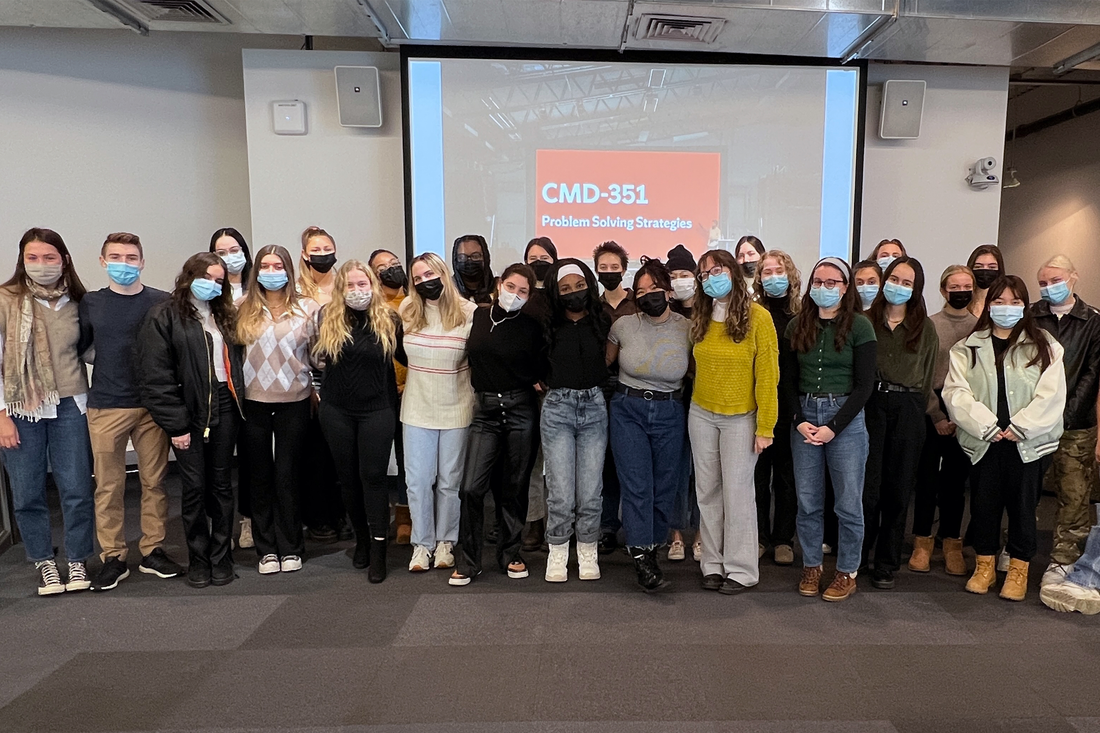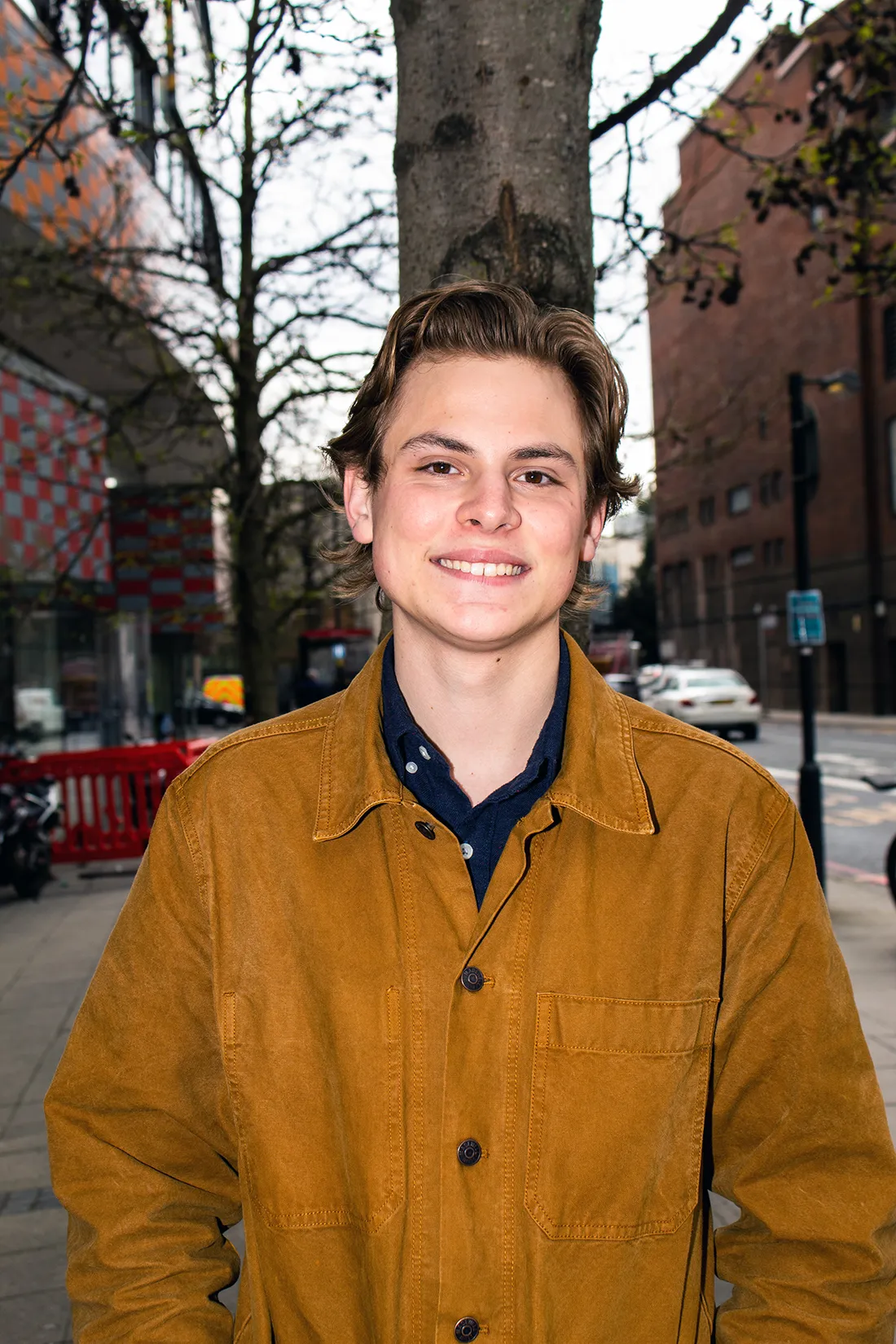
The CMD 351 class proposed seven projects that would influence sustainability on campus.
Twenty-eight students. Seven proposals. More than 3,500 hours of work.
In the Fall 2021 semester, School of Design students in the College of Visual and Performing Arts created solutions-based research projects to enhance sustainability practices at Syracuse University.
Professor of Practice Marc Stress and Assistant Professor Rebecca Kelly co-teach CMD 351 Problem-Solving Strategies, a course they say is essential to communications design majors. “As teachers of communications design, we have to prepare students for jobs that are going to look radically different than what they’re doing right now,” Kelly says. “I’m teaching students for a job that doesn’t exist yet.”
Communications designers translate ideas and information through a variety of media, and their ability to think strategically in design and marketing terms is invaluable. Graduates work as designers and creative directors at some of the leading firms in the country.
We’re training students to be leaders and thinkers, not just visual creators. We’re illuminating the importance of being thoughtful, how to do design research and how to apply that to various outputs that are relevant to modern communication.
Professor Marc Stress

Professor of Practice Marc Stress (left) and Professor Rebecca Kelly co-teach CMD 351 Problem-Solving Strategies.
To give their students hands-on experience working with a client, Kelly and Stress partnered with sustainability coordinator Melissa Cadwell from the Office of Sustainability Management. Cadwell has previously collaborated with various classes to advance sustainability efforts on campus.
The CMD 351 students developed solutions through a rigorous process based on extensive research on client needs as well as the steps of the design thinking model, which include observation, interviews, prototyping, failure and iterations. “We wanted to challenge students in a very structured, yet unique way,” Kelly says.
Both Kelly and Stress emphasized to students that the class was organized differently than most design classes as they would not begin designing until well into the semester. “The first thing students do when they get a problem is they start solving the problem,” Kelly says. “It was hard for them as designers to not come in the next day with a design.”
As teachers of communications design, we have to prepare students for jobs that are going to look radically different than what they’re doing right now. I’m teaching students for a job that doesn’t exist yet.
Professor Rebecca Kelly
Based on their research, students proposed projects that would influence sustainability on campus. Ideas included a weekly farmers market, an interactive campuswide energy dashboard and an app to guide sustainable living habits.
Stress says the proposals reflected the students’ innovation. “We’re training students to be leaders and thinkers, not just visual creators,” he says. “We’re illuminating the importance of being thoughtful, how to do design research and how to apply that to various outputs that are relevant to modern communication.”

Sustainability coordinators Melissa Cadwell (left) and Meg Lowe G’18 mentor student-interns.
An Evolving Class
Each student contributed to all the final projects, changing groups every few weeks to gain different experience in communication, scheduling and leadership. “We found historically that if student groups are working with each other over a 15-week period they can stagnate in terms of diminished learning outcomes,” Stress says.
Communications design major Dana Levine ’23 found tremendous value in the ever-changing dynamics. “The problem-solving strategies class challenged me in multitudes of ways and was structured differently than any course I have ever taken,” she says. “The changing projects taught me how to manage multiple clients at one time, which is very common in the design industry, and the open-ended structure pushed my creative boundaries.”
I learned that the problem must be dissected fully before you can start brainstorming solutions. This process takes longer than you might think but warrants a huge payoff in the end. I am confident that after this experience, I am a more well-versed designer.
Dana Levine ’23
The final project that Levine and her team pitched is called Orange Unplugged, a campuswide event where all power would be shut off for one day to raise awareness for sustainability and to promote energy reduction. “We planned fun night activities, clothing and food vendors, merchandise and advertisements all over campus,” she says.
She is grateful for the problem-solving strategies she’s gained in CMD 351. “I learned that the problem must be dissected fully before you can start brainstorming solutions,” says Levine, who plans on working in the design industry after graduation. “This process takes longer than you might think but warrants a huge payoff in the end. I am confident that after this experience, I am a more well-versed designer.”
The changing projects taught me how to manage multiple clients at one time, which is very common in the design industry, and the open-ended structure pushed my creative boundaries.
Dana Levine ’23
Creating a Path Forward
Kelly and Stress encouraged the class to be supportive of each other’s ideas, but to also identify potential roadblocks in the pitched ideas in preparation for future client work. “We know the client will challenge some of their ideas,” Kelly explains. “So, we like to pre-think all the problems and adapt. It went from a situation where Marc and I heavily guided the students at the beginning and then they started to take ownership of the critique process.”
While planning the course Kelly and Stress discussed making failure part of the learning process. “Everyone makes mistakes,” Stress says. “We wanted to bring the opportunity to fail and learn from it to the student experience because failure is where innovation happens. The concepts we’re introducing to our students teach them how to be design leaders, reinforcing that being a modern designer is more than just prettification.”

Owen Wright ’23 says that audience, accessibility, location, emotion and user experience need to be addressed before moving to a visual medium.
Kelly adds that students were not given a roadmap on how to succeed and that made them uncomfortable. “We needed students to play in the unknown because that’s where innovation is,” she says. “They had to be comfortable resolving something that they didn’t necessarily understand right away.”
Owen Wright ’23, a communications design major, says the class narrowed down a list of ideas to the best options through weeks of critique and research. “This class demonstrated how the design process works firsthand,” he says. “We went through hundreds of redrafts, scrapped concepts and alterations to achieve our finalized projects. Sometimes we had to backtrack if a project wasn’t evolving in a productive way. It was difficult, but it showed us how to be more considerate and flexible designers.”
Wright’s team proposed Otto’s Attic, a tag sale of students’ items that would prevent dorm waste from ending up in landfills and would cultivate sustainable habits among students. “The knowledge we accumulated about sustainability and environmental impact with this project was invaluable,” he says. “As designers, we have a responsibility to make designs more sustainable for the world around us.”
With the array of subjects I’ve learned in the communications design major, I feel comfortable working in any sector. I feel well-rounded as a designer and have found that many of the process and creative thinking skills have assisted me in other projects, even outside of the classroom.
Owen Wright ’23
Wright, who is pursuing a minor in English and textual studies from the College of Arts and Sciences, hopes to become a copywriter with a creative agency after graduation. “With the array of subjects I’ve learned in the communications design major, I feel comfortable working in any sector. I feel well-rounded as a designer and have found that many of the process and creative thinking skills have assisted me in other projects, even outside of the classroom.”
A Sustainable Campus Future

Professor Marc Stress (right) says the concepts introduced in CMD 351 teach students how to be design leaders.
The class introduced their proposals to Cadwell during a two-hour presentation. She is using the results of the students’ research to further many sustainability initiatives on campus and is especially interested in Orange Unplugged and Otto’s Attic.
Cadwell says this class was a beneficial collaboration. “This partnership made the students responsible for a real client. They gave us ideas for creating a way to reach and teach students about what our office does and why a sustainable campus is important.”
Stress adds the students saw the value of their research and how it gave them confidence to speak with expertise about the subject matter. “The outcomes for the class look a lot like what our students will eventually do when they get jobs in design firms, advertising agencies, marketing firms, in-house design shops and corporate communications.”

